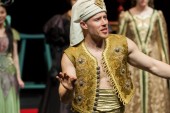
Photographer: Helene Cyr
At the tail end of a rigorous four-week rehearsal schedule, Ambur Braid couldn’t be more ready for the spotlight. Braid is a member of the Canadian Opera Company’s (COC) Ensemble Studio, an intensive, ten-student training program founded in 1980 for young opera professionals. After three years with the Studio, this Wednesday will be a graduation of sorts, as Braid preps to perform her most significant role with the company to date in La clemenza di Tito, Mozart’s last opera written in 18 days. “It’s his most refined, and most perfect, musically,” she says, dressed in a smart, emerald green Prada skirt paired with cafe-coloured knee-high boots, as we settle in to R. Fraser Elliott Hall to admire the minimally opulent set. Throughout her stint at the COC, Braid has emerged as a veritable rising vedette of the company, poised to reinvigorate old classics and be instrumental in a revival that will lure new audiences into frequenting the art form.
Instantly, it’s evident Braid is modest and thoughtful, choosing her words carefully even if it feels like she’s racing five miles a minute to get them all out. She’s currently fretting about the bits in between the arias — the solo “hits,” if you will — calling them “atrocious to memorize” because of the intricacies of the chords, but fond of them as “the heart of the storytelling,” which, from my understanding, is equal parts manic, wonderful, and vengeful. With a modest cast of six, Braid will perform the role of Vitellia, daughter of the deposed Emperor Vitellio in a one-night-only Ensemble production. “The story is about his goodness, but, in this production, we question it because although he is always benevolent, charming and forgives people, those people are then always indebted to him. So is he really that ‘good’?”
Braid was raised in Terrace, British Columbia, a small city of 11,000 people located seventeen hours north of Vancouver. The only things worth doing, she remembers, were to play sports or sing in choirs, and when she decided that athletics didn’t suit her personality, she found acting and musical theatre, and began crafting her Oscar acceptance speech. Her parents were adamant fans of Christian pop easy listening, but there was always room for Spice Girls or blues nights with her brother. She credits greats like Maria Callas as equal inspirations for her love of classical music, if not opera.
So how did a girl with such honourable intentions end up a 29-year-old empress scorned? “When you’re in this business, every day is an audition,” laughs Braid as she quickly reenacts the conversation with COC general director Alexander Neef — complete with a rather endearing homage to Neef’s German accent — during a performance sojourn to New York City that put her into the running for the challenging role of Vitellia. “I’d never looked at [the role] before in my life, but then he probably knew that. He’s one of the smartest people I’ve met, and knows opera and people’s voices so well.” Indeed, if Braid feels humbled by, or indebted to, anyone, it’s Neef for his support, a man largely credited with bringing Canadian opera into the 21st century. “He’s doing amazing things for this city. He’s actually hiring Canadians, and he’s putting people like us on that stage. That didn’t happen before.”
Ambur Braid as the Queen of the Night and Simone Osborne as Pamina in the Canadian Opera Company Ensemble Studio performance of The Magic Flute, 2011. Photographer: Michael Cooper
At 17, Braid moved to Victoria to finish her last year of high school independently. After working at a bakery and performing whenever possible, she landed to study at The Glenn Gould School at the Royal Conservatory of Music in Toronto. Shortly thereafter, another relocation took Braid to San Francisco to a pursue a master’s degree. It was here that she honed her love of opera, but ultimately quit the business altogether: “I wanted to see if I really missed it. You have to give up a lot in order to do this properly, and I wanted to make sure. I didn’t want to look back and regret giving up so many other things in my life just to perform. We treat it like it’s brain surgery and such fine-tuned work, but, really, no one’s dying here.”
During her time off, Braid worked in event marketing and dabbled in music through one-off performances at places like The Spoke Club. It wasn’t until her husband, tennis pro Kwame Gachinga, urged her to stop working her ass off only to remain unfulfilled and start getting back in to music. In 2010, Braid reluctantly conceded and began working with a coach to prepare for an Ensemble Studio audition. “That morning, I told him to tell them I got hit by a bus or something because I didn’t want to do it,” she laughs at ever having had the thought. “I didn’t care about it, only that it was my little time to perform that month.”
Braid confesses that she arrived at the COC raw and vocally unorganized, in dire need of a consistent technique. Nevertheless, her teachers and coaches seem to remember her audition fondly. “She did something in her audition that made us sit up and listen. It brought down the panel,” recalls Liz Upchurch, head of the COC’s Ensemble Studio, who auditions over 250 aspiring vocalists per year with an average of three spots available in the program. “We were all stunned by her dramatic presence that it was really quite unbelievable. She’s a captivating person, with a compelling stage presence. You can talk to her about anything and you just know she’s incredibly put together.”
Her “official” vocal designation is a dramatic coloratura soprano, a rare, three-octave voice in the opera world. According to coach Wendy Nielsen (who herself has performed the Vitellia roles), Braid’s voice has textures and tones that exude agility and power, mostly suited towards roles of queens and other nobility. Braid’s comparison is even better: “[My voice] is a bit like a Ferrari engine in a Honda body.” Fascinated by her voice, I ask her if she can hit the high screech like, say, the Mariah Careys. “Sure, but I can only do a real version, not a pop version,” tossing her hair back ever so gently. “You know, so you can hear it over an entire orchestra of 80.”
Hear Ambur’s voice for yourself
After being accepted into the program, Braid’s life morphed into ten-hour days, six days at week at the Four Seasons Centre, with rehearsal schedules that usually shift nightly. On any given day, there’s lessons in Italian language and diction, personal training, or voice lessons with as many as four different coaches. Braid speaks highly of the passion and talent of fellow members in the Ensemble Studio, who act as understudies in all the productions, learning respective roles as intensely as the principal cast. To date, however, she has never had the chance to save the day. It might not even matter, though, as her understudy days have never seemed closer than ever to being over. Her stage presence is usually what seals the deal. “She’s extremely spontaneous and wide open emotionally, willing to go there,” explains Nielsen. “She can drop into character instantly with a level of instinct she trusts. When I watch her, she’s like a cat, or a panther — all muscle and power and knows how to use what she’s got. She’s never been more ready.”
While there have been no shortage of sporadic pieces on opera’s impending demise and subsequent regenerations, you have to look no further than our backyard to see new audiences are being lured by new interpretations of old works, fundraisers like Operanation, and training programs like the Ensemble Studio turning out formidable performers like Braid. “At the COC, we’re not following that trend,” exclaims Nielsen. It would appear that the art form remains relevant if it’s done well and not treated as a museum piece, and, with new directors like Christopher Alden, who directed last year’s Die Fledermaus and now Clemenza, productions go from stuffy to great nights at the theatre. “With all these reality shows, people have an awareness of how to build a career in performance and what it takes. We’re training future vocal Olympians [at the Ensemble Studio] and people want to be right in the middle of that, hearing voices like Ambur’s.”
Braid agrees that it’s an exciting time for opera, especially in Canada. “Yeah, companies are minimizing their seasons, but that’s only making it stronger and better. It’s going to be refined, and the best of the best — the singers have to be that much better. People often talk about singers of the past being the best singers in the world, but I don’t think that’s necessarily true.” It’s not about simply performing for audiences anymore, it’s about impressing new ones. “Some people pay thousands of dollars to go places so their cellphones won’t work. Why not pay to go to the opera, turn off your phone, and escape that way?”
For now, though, she’s just one more reason to get excited about the next generation of not only the genre’s stars, but of opera as performance art. This winter, as she graduates from the Ensemble program, Vitellia will be the last time you’ll see Braid on the COC stage for the foreseeable future. In April, she’ll join Toronto-based baroque opera company Opera Atelier as The Queen of the Night in The Magic Flute. Later this year, she’ll be doing a few more yet-to-be-announced roles before heading to Arizona for a production to portray courtesan Violetta in La traviata. “Nothing shocks people these days. What we’ve got to do is move them, and this music can do that. That’s why we do this.”
If anyone could make a believer out of you, my money’s on Braid.
On Wednesday, February 6, 2013, the COC Ensemble Studio will perform the principal roles of La clemenza di Tito on the COC mainstage. All tickets $22 and $55, available online.
____
Paul Aguirre-Livingston is a Toronto-based writer and columnist for The Grid. Find him on Twitter or online.
For more, follow us on Twitter @TorontoStandard and subscribe to our newsletter.














